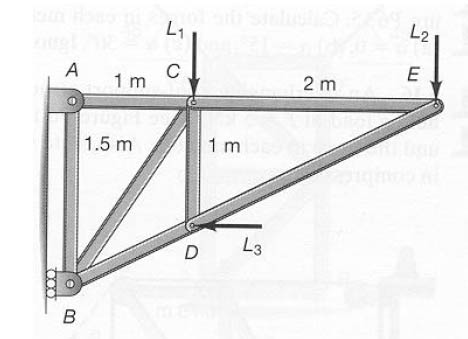CU Mechanical EngineeringStatics and Structures Matlab tutorials |
Writing Matlab Scripts: Computing forces on a truss
Writing Matlab m-files is another way to compile a series of Matlab commands into one script and is often necessary when performing complicated computations. The structure is slightly different than a function in that no values are returned and you do not pass values to the script. Commands can be entered into a scrip m-file just as they would be typed at the command prompt.
In this tutorial, we will examine the forces on a truss structure seen in the figure below and the following problem: Consider the cantilevered truss as sketched in the figure below, and calculate the forces in each member if a wind load of approximately 1000 N is added at joint D. That is, let L1 =1000N, L2 = 500N, and L N 3 =1000 . State which members are in tension and which are in compression, and determine the reaction forces as well.

The variables used in this function will be defined as follows:
| Variable | Remarks | Status |
| -------- | ------- | ------ |
| L1,L2,L3 | Forces applied at joints C, E, D respectively | To be computed |
| Lac,Lab,Lcd,Lce | Lengths of different truss members | To be computed |
| Fac,Fab,Fcd,Fce | Forces in different truss members | To be computed |
| Fbc,Fdb,Fde | Forces in different truss members | To be computed |
| Theta1 | Angle between CE and DE | To be computed |
| Theta2 | Angle between AC and BC | To be computed |
| Theta3 | Angle between BC and BD | To be computed |
| Rxa | Reaction at point A along X axis | To be computed |
| Rya | Reaction at point A along Y axis | To be computed |
| Rxb | Reaction at point B along X axis | To be computed |
| Ryb | Reaction at point B along Y axis | To be computed |
We will begin by establishing default values for the parameters of this function, as outlined below:
L1 = 1000; L2 = 500; L3 = 1000; Lac = 1; Lce = 2; Lab = 1.5; Lcd = 1;
The first task is to compute the angles. To do so, we input the following:
Theta1 = atan(Lcd/Lce); Theta2 = atan(Lab/Lac);
Using equilibrium calculations, we can analyze the forces acting on each joint, one at a time. We start by considering the equilibrium at joint E:
Fed = L2/sin(Theta1); Fce = Fed*cos(Theta1);
Next, consider the equilibrium of joint D:
Fdb = (Fed*cos(Theta1)+L3)/cos(Theta1); Fcd = Fdb*sin(Theta1) - Fed*sin(Theta1);
Now consider the equilibrium of joint C:
Fcb = (L1 - Fcd)/sin(Theta2); Fca = Fcb*cos(Theta2) + Fce;
Finally, consider the equilibrium of joint B:
Fba = Fcb*sin(Theta2) + Fdb*sin(Theta1);
We finish by computing the support reactions:
Rax = Fca; Ray = Fba; Rbx = Fdb*cos(Theta1) + Fcb*cos(Theta2); Rby = 0;
Finally, display your results with the following commands:
fprintf('The forces in members are: Fec = %gN(T)\nFed = %gN(C)\n',...
Fce, Fed);
fprintf('Fdc = %gN(C)\nFdb = %gN(C)\nFbc = %gN(C)\nFba = %gN(T)\n',...
Fcd, Fdb, Fcb, Fba);
fprintf('Fca = %gN(T)\n',Fca);